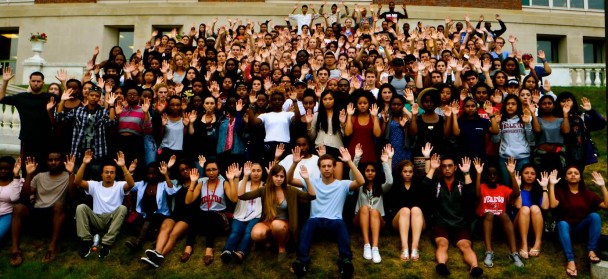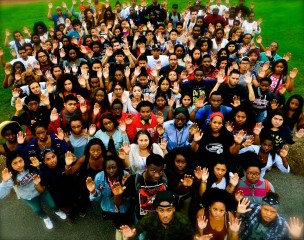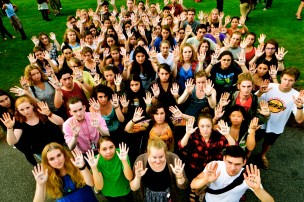"Hands Up, Don't Shoot," sparked by the shooting of Michael Brown, highlights racism and police brutality in America.
Students gathered on Andrus Field on Thursday, Sept. 11, to take a photo in solidarity with recent victims of police brutality. Titled “Hands Up, Don’t Shoot,” the photo is part of a social media campaign designed to highlight racism and police brutality in the United States. The “Hands Up, Don’t Shoot” online hashtag was sparked by the death of Michael Brown, an unarmed black teenager who was shot by police in Ferguson, Missouri on Aug. 9.

Dreisen Heath ’15 orchestrated the photo shoot. Heath, who serves as the co-chair of Ujamaa, a campus student of color organization, organized the event in conjunction with other campus affinity groups, including Invisible Men and the Women of Color Collective.
Heath stated that she sought to bring this movement to Wesleyan in solidarity with and in honor of Brown.
“Wesleyan is known for public displays of activism,” Heath said. “Particularly with race, I don’t think it’s always been done. [The photo] would be a great opportunity for affinity groups to unify.”
The demonstration was held on Andrus Field and included three separate photographs. The first, involving all students in attendance regardless of race or background, was meant to show the University community in solidarity with one another.
Organizer Alton Wang ’16 stated that participants and organizers alike wished to present the school as a united front against racism and police brutality.
“College campuses have been breeding grounds for change and social movements,” Wang wrote in an email to The Argus. “Thus, such displays of solidarity can be strong in eliciting discussion and awareness, as well as compelling individuals in our community to commit to change or take action.”

The second photo involved affinity groups and people of color, identified as those primarily victimized by incidents such as the Brown shooting. This photo was taken as part of the original “Hands Up, Don’t Shoot” movement, formed by members of Ferguson’s black community.
Heath spoke to the importance of a photograph in capturing the racial nature of police brutality in the U.S.
“We should not take away from the originality and significance of this specific movement,” Heath said. “You don’t want to take away the agency from victims who actually are targets and endure this pain.”
The third photo, composed of allies, was taken in tribute to the movement “Don’t Shoot In My Name.” The campaign, circulated on media sites such as Twitter and Tumblr, requires allies to write “Don’t Shoot” on their right hands and “In My Name” on their left hands, while also holding both hands in the air. The purpose of this photo was for allies to show their solidarity and honor Brown, as well as others lost to similar tragedies.
Heath emphasized that the organizers wanted the event present at the University as a unified force against racism and brutality.

“I definitely hope [the photos] show a unification of Wesleyan,” Heath said. “I know at times there’s been rifts between the [students of color] and white students at school, and I just want it to be a place where, on a human-to-human basis, there’s appreciation for one another, a time when we can come together and be in solidarity with one another.”
Michael Ortiz ’17 participated in the photo shoot and stated that the number of students present was a testament to the social awareness of the University community.
“I think it’s great that people showed up and that people care,” Ortiz said. “It shows Wesleyan students are aware there’s things in our country that are kind of messed up, and we need to fix it one step at a time.”
Wesleyan is not the first university to participate in the movement. Howard University’s “Hands Up, Don’t Shoot” photo went viral after students discovered that a university alumna had been shot while protesting in Ferguson. Since then, numerous schools around the country have joined the online movement to show solidarity with victims of police brutality.
Heath spoke to the significance of the campaign in terms of organizing students for future activism.
“I think [the movement] is very important, because we are the future generation,” Heath said. “It’s all in our hands. We have to pass it along, and we have to have those tools to pass it along.”
1 Comment
Victor LaWanda Asuquo
St. Louis, Missouri thanks you all for showing the importance of Love and Justice! You guys made St. Louis History!
“On September 11, 2014, students gathered on Andrus Field to take a photo
in solidarity with recent victims of police brutality. Titled “Hands
Up, Don’t Shoot,” the photo is part of a social media campaign designed
to highlight racism and police brutality in the United States. The
“Hands Up, Don’t Shoot” online hashtag was sparked by the death of
Michael Brown, an unarmed black teenager who was shot by police in
Ferguson, Missouri on Aug. 9. http://wesleyanargus.com/2014/09/11/hands-up-dont-shoot”
http://en.wikipedia.org/wiki/St._Louis